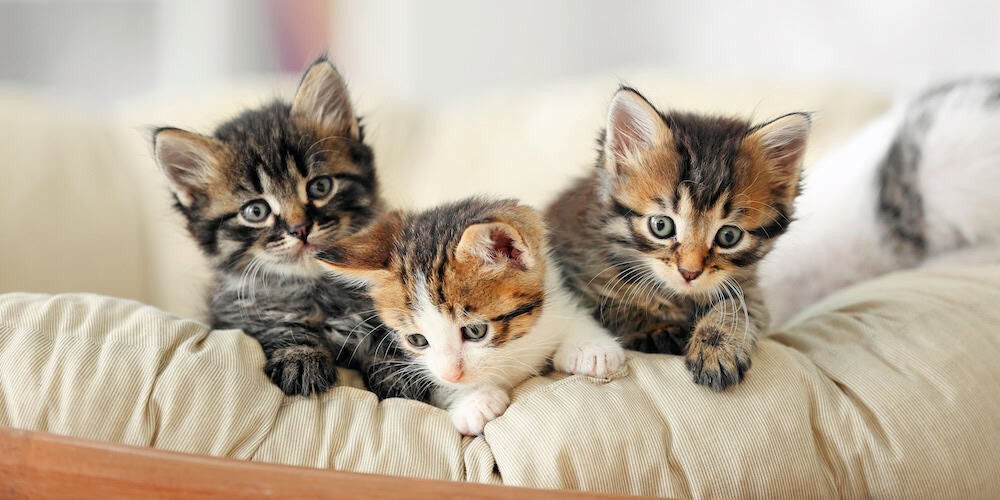Weaning is a crucial stage for dogs and cats. It should not be overlooked because problems can arise if it is not carried out correctly.
It’s a gradual process that starts at around 4 weeks of age and ends at 8 weeks, when kittens are considered independent.
This is why a kitten cannot be adopted before this time, as it is still dependent on its mother.
It is also a provision in the Rural and Maritime Fishing Code: “Only dogs and cats older than eight weeks may be transferred free of charge or for payment,” according to Article L214-8.
Thinking about weaning means considering a dietary transition. Other factors come into play during this stage of a kitten’s life, but nutrition is essential. I share the steps and my tips for successful weaning.
📚 Also read | The best cat kibbles analyzed by a veterinarian
1. Choose the right food at the right time
From birth until about 3 to 4 weeks of age, kittens are fed exclusively on mother’s milk. It meets their nutritional needs and provides them with water. This is the lactation period.
The start of weaning marks a change in diet. Kittens then begin to consume solid food. It is the gradual emergence of their teeth that enables them to eat solid food.
I recommend that you always offer a diet appropriate for the kittens’ age. This helps meet their nutritional needs, which are necessary for proper growth.
2. Gradually introduce solid food
You can start offering solid food to kittens from 4 weeks of age. It should be moist.
For example, I recommend offering kibble that has been pre-soaked in warm water.
Several small meals a day are necessary. Ideally, free-feeding allows them to eat throughout the day.
I recommend using a shallow dish, or an easily accessible container, to place the food.
Over the weeks, kittens will consume less and less milk, and therefore more and more solid food.
Food should be offered in increasing proportions as the consumption of mother’s milk decreases.
3. Continue with solid food after weaning
Once kittens are eating only their solid food and no longer drinking their mother’s milk, you can continue with solid food specially formulated for kittens until adulthood, which is about one year.
Don’t hesitate to regularly check the condition of their stools and contact a veterinarian at the slightest concern. The same applies in cases of vomiting or loss of appetite.
4. Don’t rush
Early weaning can cause stress in both the mother and the kittens! Behavioral problems may then appear, as shown by this study.
Indeed, weaning isn’t just about feeding. Kittens become fully independent: grooming, bathroom needs, etc.
5. Also offer water
Water can also be offered around 4 weeks of age. However, kittens may not be interested, especially because solid food contains much more water at the start of weaning (moistened kibble, etc.).
Kittens will drink water on their own when the kibble contains less water.
Fresh water should still be made available during weaning and changed regularly. I recommend using a small, shallow dish.
Be careful, as a large water bowl could wet the kittens if they fall in. Because they are more susceptible to hypothermia, you need to make sure they don’t get wet.
Keeping the kittens clean and dry throughout the weaning period is necessary to prevent health problems.
6. Give small amounts
At first, you can offer the food directly from your finger or use a spoon. You should normally see the kittens gradually start eating the solid food on their own.
I recommend changing the food regularly. The kittens will probably end up walking in the dish!
For good hygiene of the food and the kittens, I recommend offering small quantities to avoid ‘spoiling’ the food.
7. Pay special attention to some kittens
Sometimes the mother cannot properly nurse her kittens, either because she does not provide enough milk, or because she cannot nurse at all.
A supplementary or replacement feeding is therefore essential. The same applies to orphaned kittens.
Be careful not to give cow’s milk to kittens. It is not suited to their needs and can also cause digestive problems. For more information, you can consult the article I wrote on the subject.
If you have orphaned kittens, I recommend consulting a veterinarian. They can guide you on how to bottle-feed your kitten properly, especially if it is less than 4 weeks old. You can find my advice on feeding a kitten here.
A kitten may also not eat enough if the others prevent it from eating its fill due to competition. They deserve particular attention to prevent nutritional deficiencies.
8. The importance of weighing
Weighing each kitten regularly and monitoring changes in their weight in a notebook allows you to notice any potential problem. Indeed, weight loss can indicate a health issue.
It is recommended to weigh kittens daily until 2 weeks of age. Then, twice a week until weaning.
These weigh-ins can be more frequent in the case of a sick kitten. The scale should be suitable and as accurate as possible. Ideally to within 1 gram.
Be aware that all these values are averages. It is therefore important to closely observe each kitten individually. Some will wean quickly; others will need support for longer.
In any case, I recommend consulting a veterinarian.
Sources and scientific studies
Ahola M, Vapalahti K, et al. Early weaning increases aggression and stereotypic behavior in cats. Sci Rep. 2017.
Veronesi MC, Fusi J. Feline neonatology: From birth to commencement of weaning – what to know for successful management. Journal of Feline Medicine and Surgery. 2022.



